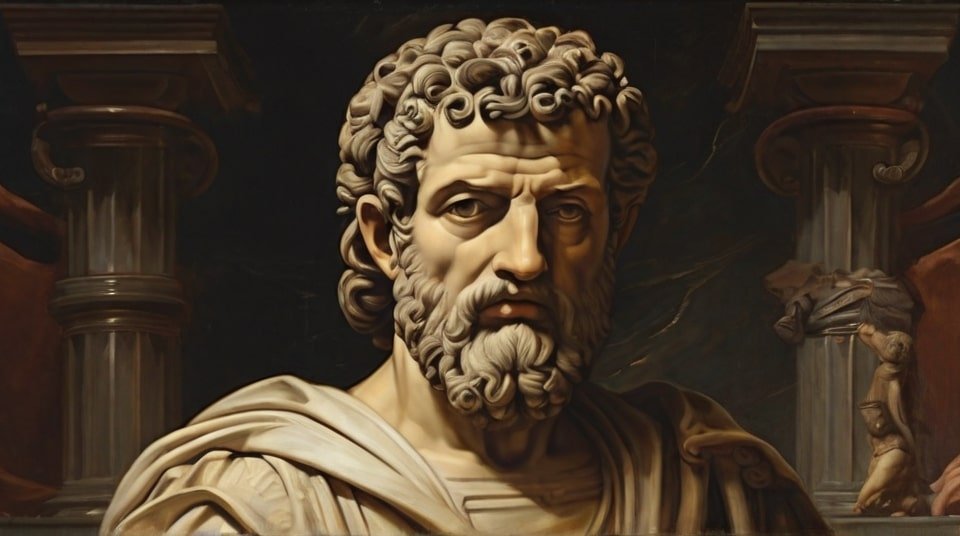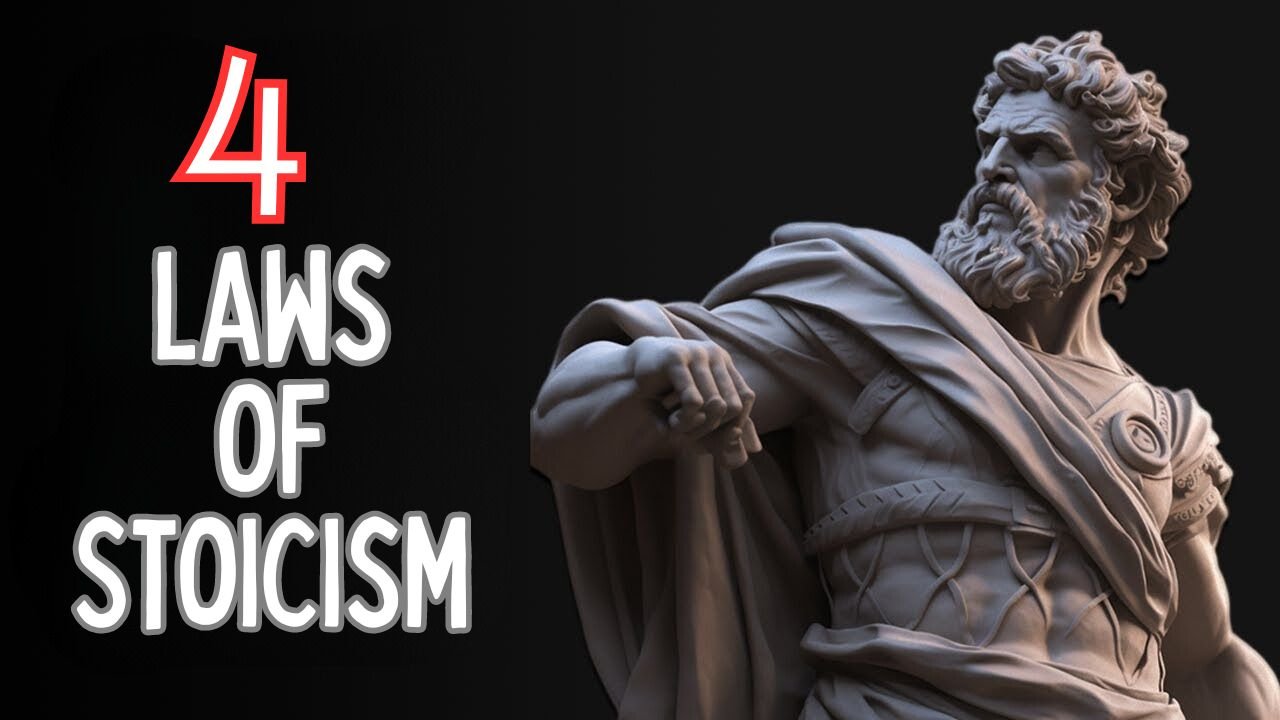I. Introduction

A . Definition of Stoicism
Stoicism, often misunderstood as an emotionless philosophy, is, in fact, a profound and practical guide to navigating life’s challenges with resilience and wisdom. Rooted in ancient Greek philosophy, Stoicism’s core principles have transcended centuries, offering timeless insights into the human experience. At its essence, Stoicism encourages individuals to cultivate inner strength, tranquility, and virtue in the face of external circumstances. A stoic, therefore, is not someone devoid of emotions but rather someone who acknowledges them, yet maintains control over their responses. Stoicism teaches that while we can’t always control external events, we have the power to govern our reactions, fostering a sense of empowerment amidst life’s uncertainties.
Central to Stoicism is the distinction between what is within and beyond our control. This foundational concept encourages individuals to focus their energy on aspects they can influence, fostering a pragmatic and proactive mindset. Stoics also emphasize the importance of distinguishing between internal factors, like our thoughts and actions, and external circumstances, over which we have limited control. This nuanced approach promotes a resilient attitude, allowing individuals to weather the storms of life with grace and composure.
The Stoic philosophy finds embodiment in historical figures like Zeno, Seneca, Epictetus, and Marcus Aurelius, whose teachings continue to inspire millions today. Seneca’s letters, Epictetus’ discourses, and Marcus Aurelius‘ “Meditations“ serve as accessible entry points into Stoic wisdom, offering practical guidance on applying its principles to daily life.
In embracing Stoicism, one embarks on a journey toward personal growth, ethical living, and a profound understanding of the interconnectedness of individuals and the cosmos. Far from a rigid doctrine, Stoicism remains a flexible and adaptable philosophy that empowers individuals to lead lives of purpose, virtue, and fulfillment, making it as relevant today as it was in ancient Greece.
B. Teasing the 4 laws of Stoicism
1. Importance of principles in Stoic philosophy
At its core, Stoicism encourages individuals to focus on what is within their control – their attitudes, beliefs, and responses to life’s events. This pragmatic approach empowers people to navigate the unpredictable nature of existence with a sense of purpose and resilience. Seneca, another influential Stoic philosopher, believed in the importance of reason and the rational examination of one’s own life. He argued that by embracing Stoic principles, individuals could lead lives of tranquility and ethical integrity.
Stoicism, often associated with the famous metaphor of an archer aiming at a target, teaches that while external circumstances may be beyond our control, our internal reactions and choices are not. By understanding and embodying these principles, individuals can cultivate a robust mental and emotional fortitude, allowing them to face challenges with a calm and composed demeanor. The practicality of Stoic philosophy lies in its applicability to everyday situations, making it a valuable guide for modern life.
In essence, Stoicism isn’t just a historical relic but a living philosophy that can enhance the quality of contemporary living. Its principles resonate across time, offering a timeless toolkit for individuals seeking personal development, emotional resilience, and a meaningful connection with the world around them. Embracing Stoicism means embracing a mindset that transcends fleeting circumstances, inviting individuals to lead lives marked by virtue, wisdom, and an unwavering commitment to principles that stand the test of time.
2. How the laws guide individuals in daily life
The laws of Stoicism, grounded in principles that transcend time, serve as an invaluable compass guiding individuals through the complex terrain of daily life. Rooted in the teachings of ancient Stoic philosophers like Zeno, Seneca, Epictetus, and Marcus Aurelius, these laws encapsulate a practical philosophy that speaks directly to the human experience. The first law emphasizes the dichotomy of control, urging individuals to focus on what lies within their power – their thoughts, actions, and responses.
This resonates with the core Stoic idea that external circumstances are beyond our control, but our reactions are not. The second law, rooted in Seneca’s teachings, highlights the value of reason in navigating life’s challenges. By embracing rationality, individuals can cultivate resilience and tranquility amid the uncertainties of the modern world.
Epictetus, in his contributions to Stoicism, underlines the importance of distinguishing between what is within and beyond our control – a key facet of the third law. This principle encourages individuals to channel their energy into areas where they can make a meaningful impact, fostering a sense of empowerment and purpose. Marcus Aurelius, in the fourth law, guides individuals to align their lives with the natural order, emphasizing virtues like wisdom, courage, justice, and temperance.
In daily practice, these laws become more than philosophical concepts; they become a blueprint for ethical living, resilience, and personal growth. As individuals navigate the complexities of the contemporary world, the laws of Stoicism offer a sturdy framework, providing direction and clarity in the pursuit of a balanced and purposeful life.
C. Engaging hook to capture the reader’s attention
Embarking on a journey into the timeless wisdom of Stoicism is like stepping into a sanctuary for the soul, where the echoes of ancient philosophers resonate with the complexities of our modern lives. Picture this: you, a modern-day Stoic, navigating the hustle and bustle of the 21st century armed not with the chaos of stress but with the serenity of Stoic principles. As you stand at the intersection of philosophy and daily life, the teachings of Zeno, Seneca, Epictetus, and Marcus Aurelius beckon you to explore a profound path towards tranquility, resilience, and self-discovery.
In a world pulsating with information and incessant demands, Stoicism emerges not as a distant philosophy but as a friendly guide, offering timeless insights that transform the ordinary into the extraordinary. Join me on this expedition into the heart of Stoicism, where ancient wisdom meets contemporary challenges, and the journey is not just philosophical but deeply personal. Let’s unravel the secrets of the Stoic way together, inviting tranquility and purpose into our lives, one thought at a time.
II. Unveiling the 4 Laws of Stoicism

A. Law 1: Distinguish between what’s within and beyond your control
1. Explanation of the first law
Embarking on the exploration of Stoicism, we encounter its first law as a guiding principle that illuminates the path to a more resilient and fulfilling existence. At its heart, Stoicism urges us to discern between what we can control and what lies beyond our influence, a timeless wisdom championed by stoic luminaries such as Zeno, Seneca, Epictetus, and Marcus Aurelius. Picture it as a compass pointing us toward a more intentional life—a life governed by conscious choices rather than the whims of external events. This Stoic compass directs our attention to the inner sanctum of our thoughts, actions, and responses, reminding us that true freedom arises when we focus on the aspects of life under our command.
As we delve into the nuances of this foundational Stoic law, we discover the transformative power it holds. It’s not just an ancient philosophy; it’s a practical toolkit for facing the challenges of the modern world with resilience and clarity. So, let’s unravel the layers of the first law of Stoicism, forging a connection between ancient wisdom and contemporary living, as we embark on a journey toward a more stoic and purposeful existence.
2. Practical examples and anecdotes illustrating the concept
Venturing into the realm of Stoicism, the first law’s practicality shines through anecdotes that resonate across time and circumstance. Imagine facing a challenging work situation: deadlines loom, pressure mounts, yet amid the chaos, a stoic mindset directs focus to the tasks at hand, the aspects within one’s control. Take the example of a commuter caught in unexpected traffic—instead of succumbing to frustration, the stoic individual acknowledges the external nature of the delay while utilizing the time to engage in a mindful activity. These instances underscore Stoicism’s relevance in daily life, demonstrating how a deliberate shift in perspective can transform obstacles into opportunities.
Stoic principles aren’t confined to ancient scrolls but are living, breathing guides for the modern soul. By weaving these practical examples into the fabric of our daily narratives, the first law of Stoicism becomes not just a concept but a lived reality, enriching our experiences and nurturing resilience in the face of life’s unpredictable currents. So, let’s explore these vivid illustrations, allowing the wisdom of Stoicism to permeate our lives and bring about a profound, positive change.
B. Law 2: Focus on internal factors rather than external circumstances
1. Delving into the second law
Embarking on the exploration of Stoicism’s second law unravels a profound journey into self-awareness and personal accountability. Imagine navigating the tumultuous seas of life, where external events often seem uncontrollable. The stoic individual, armed with the second law, discerns the line between the controllable and the uncontrollable, akin to a skilled sailor navigating through stormy waters. This law acts as a compass, guiding us to focus energy where it matters—the internal realm of our thoughts, emotions, and choices. Through this Stoic lens, we gain mastery over reactions, cultivating a serene inner sanctuary amidst life’s tempests. The second law doesn’t deny external challenges but empowers us to choose our responses consciously.
Consider the analogy of a tree bending with the wind, not resisting, but adapting and ultimately standing resilient. Thus, embracing the second law of Stoicism invites us to be architects of our reactions, fostering a mindset that, like the tree, remains steadfast amid the ever-changing winds of circumstance. As we delve into this law, let’s embrace its transformative power, turning life’s challenges into opportunities for personal growth and enduring tranquility.
2. Real-life applications and benefits
Unlocking the practical applications of Stoicism and embracing its tenets in daily life is akin to discovering a timeless guide to navigate the complexities of the modern world. Picture a stoic individual facing the challenges of a hectic workday—the first law guiding them to differentiate between what is within their control and what is not. In the face of unexpected setbacks, they invoke the second law, redirecting focus to their internal responses rather than futilely resisting external events. This conscious shift in perspective fosters resilience and mental fortitude.
Consider the stoic commuter, stuck in traffic—an embodiment of the third law. Instead of succumbing to frustration, they align with the natural flow of things, recognizing the impermanence of the situation. By practicing the fourth law, the stoic doesn’t merely endure the commute but transforms it into an opportunity for mindfulness or educational podcasts.
In real-life applications, Stoicism becomes a toolbox for emotional regulation, decision-making, and ethical living. It’s not just a philosophy; it’s a dynamic companion offering a steadfast approach to life’s uncertainties. By embodying these principles, individuals can experience enhanced well-being, improved relationships, and a profound sense of inner peace—the timeless rewards of adopting a stoic mindset.
C. Law 3: Differentiate between what belongs to you and what doesn’t
1. Insight into the third law
The third law of Stoicism introduces a transformative perspective on embracing life’s inherent unpredictability. Picture a stoic standing amidst the ebb and flow of circumstances, embodying this law with serene acceptance. In essence, it encourages individuals to cultivate an understanding of the interconnectedness of their lives with the broader cosmic order. When faced with adversity, a stoic doesn’t resist or resent the inevitable changes but rather aligns themselves with the natural course of events.
Consider the changing seasons—an apt metaphor for the fluctuations in life. The stoic, inspired by the third law, learns to navigate the various seasons of existence, recognizing that, much like nature, life is a continuous cycle of growth, decay, and rebirth. By internalizing this Stoic principle, individuals find solace in the transient nature of challenges, allowing them to adapt and evolve.
The third law becomes a guiding beacon for resilience, encouraging individuals to view setbacks not as insurmountable obstacles but as integral parts of their personal journey. In this way, Stoicism, with its timeless wisdom, offers a roadmap for navigating the complexities of life with grace and equanimity. Embracing the third law is not just an intellectual exercise; it’s an experiential shift that fosters a profound sense of peace amid the unpredictable symphony of existence.
2. How this law aids decision-making and personal growth
The third law of Stoicism, often regarded as a compass for navigating life’s unpredictable waters, holds profound implications for decision-making and personal growth. Picture a stoic contemplating a crucial choice, grounded in the wisdom of this law. By acknowledging the interconnectedness of their decisions with the broader cosmic order, a stoic gains clarity on the transient nature of circumstances. This realization empowers them to make decisions not rooted in fear or anxiety but guided by a deep understanding of the ebb and flow of life.
In the realm of personal growth, the third law becomes a catalyst for transformation. Embracing the inevitable changes and uncertainties, a stoic cultivates resilience and adaptability. Much like a tree bending with the wind but staying firmly rooted, individuals rooted in Stoicism find strength in flexibility. Decision-making becomes an opportunity for self-discovery and refinement rather than a source of stress. This Stoic perspective fosters a continuous loop of learning and growth, where each decision, whether perceived as a success or failure, contributes to the individual’s evolution.
In essence, the third law acts as a lighthouse, guiding stoics through the turbulent seas of life. By aligning decisions with the natural order of the universe, individuals not only enhance their capacity for wise choices but also embark on a journey of continuous self-improvement and personal development.
D. Law 4: Live in accordance with nature
1. Exploring the fourth law
The fourth law of Stoicism, a beacon of serenity in life’s storms, revolves around the understanding that we can only control our reactions to external events, not the events themselves. Picture a stoic facing adversity with a calm demeanor, guided by the wisdom of this law. In the face of challenges, a stoic embraces a mindset that prioritizes internal mastery over external circumstances. This principle is not about suppressing emotions but about channeling them productively.
Consider the image of a stoic facing a setback; instead of succumbing to frustration, they leverage their emotional energy to fuel resilience and determination. This Stoic perspective empowers individuals to respond to adversity with grace, learning, and growth. By acknowledging the uncontrollable nature of external events, stoics liberate themselves from the burden of undue stress and anxiety, cultivating a profound sense of inner peace.
The fourth law, therefore, acts as a cornerstone for emotional intelligence and mental well-being. It invites individuals to embrace a mindset where challenges are viewed as opportunities for personal development. As we navigate life’s unpredictable terrain, the Stoic philosophy encourages us to focus on what we can control – our attitudes, responses, and choices. This transformative perspective allows stoics to sail through the turbulence of life with resilience, wisdom, and an unwavering commitment to inner harmony.
2. Practical tips for aligning with nature in daily life
In weaving the fabric of daily life with Stoic threads, practical tips for aligning with nature become invaluable guides on this philosophical journey. Picture a stoic awakening each morning with a deliberate intention to synchronize their actions with the rhythm of the universe. It’s about embracing the ebb and flow of life, recognizing that change is a constant, much like the changing seasons. The stoic, in their pursuit of virtue, finds solace in simplicity, harmonizing with the fundamental principles of nature.
Imagine a day unfolding where decisions are rooted in wisdom, understanding, and compassion, much like the stoic’s approach. Balancing the demands of modern life, a stoic cultivates mindfulness, attentively discerning what is within their control and what lies beyond. Whether facing success or adversity, the stoic maintains an unwavering commitment to virtues like wisdom, courage, justice, and temperance.
Practical application of Stoicism involves grounding oneself in the present moment, acknowledging the interconnectedness of all things, and appreciating the beauty of simplicity. This alignment with nature, as espoused by Stoicism, transforms mundane routines into opportunities for growth, reflection, and the pursuit of a virtuous life. In these simple yet profound daily practices, the stoic crafts a life in consonance with the grand symphony of the cosmos, finding fulfillment and meaning in each deliberate note.
III. Conclusion
A. Recap of the 4 laws of Stoicism
As we embark on the journey through the rich tapestry of Stoicism, let’s take a moment to recap the four guiding laws that shape this philosophical landscape. Stoicism, a beacon of wisdom, offers a compass for leading a meaningful and virtuous life. The first law beckons us to focus on what is within our control, fostering resilience and tranquility amidst life’s uncertainties. The second law, a call to distinguish between internal values and external events, empowers the stoic to navigate challenges with unwavering inner strength.
Moving to the third law, we find insight into the importance of acceptance and the alignment of our desires with the natural order of the cosmos. This fosters a serene acceptance of life’s unfolding journey. Finally, the fourth law invites us to align with nature, emphasizing the pursuit of virtue and wisdom. Picture the stoic embracing the present, harmonizing with the ebb and flow of existence. Together, these laws offer not just a roadmap but a profound philosophy for a life well-lived. In practicing Stoicism, one discovers not just principles, but companionship in the journey towards wisdom, courage, justice, and temperance, crafting a life that resonates with the very essence of what it means to be stoic.
B. Encouragement for readers to apply Stoic principles
Dear fellow seekers of wisdom, consider the profound
philosophy of Stoicism not as a distant theory but as a trusted companion in the journey of life. Embracing Stoic principles is not about erecting an unattainable fortress of unfeeling detachment; it is an invitation to weave resilience, wisdom, and tranquility into the very fabric of our existence. As we navigate the unpredictable currents of life, Stoicism provides a sturdy vessel, guiding us to focus on what is within our control, cultivate inner strength, and harmonize with the natural order. Picture yourself standing on the shores of acceptance, gazing at the vast sea of existence with equanimity.
Let Stoicism be your compass, guiding you through the storms and calms alike. In the realm of virtues, Stoicism is a wise and friendly mentor, encouraging the pursuit of wisdom, justice, courage, and temperance. Apply these principles not as rigid laws but as flexible companions, adapting to the nuanced dance of daily life. Like a trusted friend, Stoicism whispers encouragement in your ear, urging you to align with your values, accept the inevitable, and live virtuously.
Embrace the Stoic mindset, and witness how it transforms challenges into opportunities, adversities into stepping stones, and each moment into a well-lived experience. The journey is yours, and Stoicism, a steadfast ally, walks beside you, inviting you to infuse every step with the grace of a true stoic.
C. Call-to-action for further exploration and self-improvement
Embark on the enriching journey of self-discovery and resilience by delving deeper into the timeless philosophy of Stoicism. Let the wisdom of Stoic principles be the lantern guiding you through life’s labyrinth. As you navigate the intricacies of existence, explore the vast reservoirs of Stoic literature from the works of Zeno, Seneca, Epictetus, to the profound insights of Marcus Aurelius. Immerse yourself in the ocean of Stoic teachings, and witness how these ancient truths resonate with the challenges of the modern world. Attend to the whispers of virtue and the call to align with nature, for Stoicism is not a mere philosophy; it is a way of life.
Take proactive steps towards personal growth and well-being by incorporating Stoic practices into your daily routine. Whether it’s journaling, mindful reflection, or embracing the Stoic exercises, you’ll find these tools invaluable on your journey. Join the community of fellow seekers, share insights, and learn from the collective wisdom of those treading the Stoic path. Embrace Stoicism not as a rigid set of rules but as a compassionate guide, empowering you to face life’s uncertainties with grace and fortitude.
Seize this moment to cultivate the virtues of wisdom, courage, justice, and temperance, and let Stoicism be the compass that leads you to a more resilient and fulfilled life. The Stoic journey awaits—embrace it with an open heart and a curious spirit.
D. Friendly closing remarks, inviting comments and engagement
As we conclude this exploration into the profound principles of Stoicism, let this not be the end but rather the beginning of a shared journey. I invite you, dear reader, to share your thoughts, experiences, and insights on Stoicism. Your unique perspective adds color to the canvas of collective wisdom. What Stoic practices resonate with you, and how have they influenced your daily life? Feel free to leave your reflections, questions, or anecdotes in the comments below. Let this space become a forum for the exchange of ideas and a community of like-minded individuals on the path to becoming more resilient, compassionate, and, ultimately, more Stoic.
Together, let us forge a camaraderie that reflects the essence of Stoicism—fostering wisdom, virtue, and a deep understanding of the human experience. Your voice matters, and in the spirit of Stoic philosophy, let us embrace the opportunity to learn and grow together. May your journey be filled with tranquility, and may the Stoic flame within you burn brightly.







